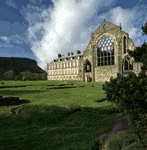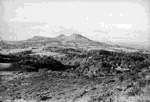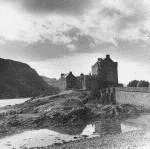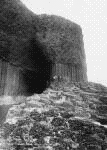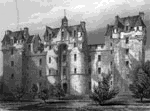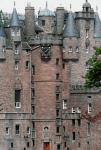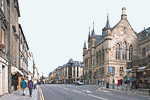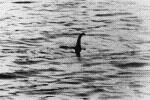|
Travel Mysterious Scotland - page 2
Edinburgh, Lothian (Witchcraft, Haunting, Astrology)
Numerous people accused and persecuted for witchcraft were burned on Castle Hill in Edinburgh. The gallows were used there until the 19th century. A small fountain has now been built on Castle Esplanade to mark the spot where witches and warlocks were burned.
At Holyrood (reputedly haunted by the ghost of Mary Queen of Scots secretary who was killed there by her husband Lord Darnley) King James VI of Scotland examined a number of the North Berwick witches. Agnes Sampson who denied the charges was forced to have all her bodily hair shaved off so the king could search for the 'Devil's Mark'. An appropriate mark was found on her body. As a result of this find, she was put into a 'witches bridle' (ie a pronged iron vice was placed in her mouth with 2 sharp prongs which pierced her cheeks) while simultaneously being burned by ropes drawn over her face. Being tortured in this manner she began to admit numerous evil deeds.
Major James Weir who was executed for witchcraft in 1670 once lived in a house in the Bow. It is still said to be haunted by Major Weir himself who has been seen to come riding out of the house on a black headless horse.
On top of the building on the corner of Princes Street and South St Andrew's Street is a zodiacal band on a planisphere supported by statues of Cupid.
The current Bank of Scotland building on George Street is decorated with the 12 astrological signs of the zodiac above the door.
Eildon Hills, Borders (King Arthur)
According to legend, a man walking on the Eildon Hills entered the cave in which Arthur and the Knights lie asleep awaiting the hour when England needs them. Hanging from the roof were a horn and a sword. The man sounded the horn rather than drawing the sword and he was blown from the cave by a magical wind. The entrance to the cave disappeared when the man told his story to some shepherds.
Eilean Donan, Highlands (Haunting, Highlander)
Beautiful Eilean Donan castle (used as a location in the film Highlander) is said to be haunted by a Spanish soldier. A photograph taken inside the castle showed a disembodied head which some say is the ghost of Eilean Donan.
Elgin, Grampian (Pictish Carving)
Elgin Museum contains the famous pictish stone carving known as the 'Burghead Bull' found during the excavation of Burghead well. It also contains numerous exhibits of interesting symbolism and other curious artifacts.
Findhorn, Grampian (Fairies)
The Findhorn Foundation community is known for its dedication to a spiritual return to nature involving the cultivation of spiritual ties with nature elementals (fairies and elves). It is famous also for the astounding growth of the plants there.
Fingal's Cave, Strathclyde (Giants)
Fingal's Cave is a natural formation on the Island of Staffa which, legend has it, was built by a race of giants. It is about 75 metres deep and over 30 metres high. It has all the majesty of a fine cathedral. It is famous for the music it makes - a booming organ-like noise produced by the air being forced into the cave by incoming waves.
Forres, Grampian (Witchcraft)
From Cluny Hill, witches were rolled in stout barrels through which spikes were driven. Where the barrels stopped, they were burned. Isabel Simpson was burned in the main square of Forres in 1662 for making a wax-image of King Duff and melting it over a fire. A witches stone is set into a wall on the A96 which marks the spot where a witch was burned.
Fort William, Highlands (Secret Portrait)
Two blurred crescents painted onto a wooden tray are kept in the West Highland Museum at Fort William. When a polished cylinder in placed between the crescents, a perfect image of Bonnie Prince Charlie is reflected. This allowed those who supported the Prince to be able to toast his health and success without the danger of having a conventional image in sight.
Fyvie Castle, Grampian (Devil)
The gardens of Fyvie Castle have a pedestal carved with images of the cloven-hooved Devil or Pan.
Glamis, Tayside (Macbeth, Devil, Witchcraft)
Glamis Castle's many ghost's include Macbeth (Shakespeare even uses Glamis Castle in the play Macbeth as the place where Macbeth killed Duncan). A secret chamber where one of the Lords of Glamis is said to have played cards with the Devil, according to legend contains a bricked up monster. The Devil's Gate (now the south entrance) is decorated with 2 demons. Lady Jane Douglas the widow of Lord Glamis was executed for witchcraft in 1537.
Glendevon, Tayside (Witchcraft)
John Brugh arrested for witchcraft in 1643 was alleged to have met the Devil in the churchyard of Glendevon Church on at 3 separate occasions. On the exterior wall of the church is a raised skull which allows light to fall behind the sockets giving the impression that the eyes are glowing.
Glenluce, Dumfries and Galloway
A 'plague-demon' was stopped by a local wizard in the 13th century when he locked it into one of the vaults in Glenluce Abbey. From 1654-56 a house in Glenluce was visited by a poltergeist known as the Devil of Glenluce which threw stones around, started fires and produced demonic voices.
Haddington, Lothian (Witchcraft)
Agnes Sampson, the 'wise wife of Keith' who was tried for witchcraft at North Berwick once lived in Haddington.
Hermitage, Borders (Witchcraft)
Hermitage castle was the home of William, Lord Soulis is said to have been the most evil wizard in Scottish history. Legend has it that the force of his evil made the squat castle sink into the ground. According to the story by Dr John Leyden, the wicked Baron de Soulis had been convinced of his indestructibility by his spirit familiar who told him that only a rope of sand could restrain him. The wise wizard Thomas of Ercildoune made a belt of lead with which he encircled Baron de Soulis while he was asleep. He the poured sand into it and to him to the nearby stone circle, Nine Stane Rig, and boiled him to death in a vast cauldron.
Humbie, Lothian (Witchcraft)
The village of Nether Keith was where Agnes Sampson came from. She is said to have confessed to King James VII that she had met the Devil 'in man's likeness' close to her home in Nether Keith.
Innerleithan, Borders (Devil)
Every year an effigy of the Devil is burnt on a bonfire (the burning of the Deil). there then follows a procession from Caerlea Hill through the town. As the ritual takes place close to the sun's entry into the sign of Leo, it is probably derived from an ancient pagan ritual.
Innerwick, Lothian (Haunting)
The Cool Ghost of Innerwick which is reputed to haunt Innerwick Manse is said to be the ghost of Mr Maxwell who came from the village of Cool and died at the Manse in 1724. It is one of 3 ghosts which are thought to haunt various houses in the village and has been seen by numerous people over the years.
Inshoch, Highlands (Witchcraft)
The ruins of Inshoch castle is the place where Isobel Goudie claimed to have met the Devil and where she learned her spellcraft.
Inverkip, Strathclyde (Witchcraft)
Eighteen people were tried for witchcraft in the tiny village of Inverkip. Amongst them was 18 year old Marie Lamont who was tortured into confessing that she often had sexual intercourse with the Devil who appeared at the sabbats in the form of a big brown dog and that He had left the 'Devil's Mark' on her by nipping her on her side.
Inverness, Highlands (Witchcraft, Loch Ness Monster)
Margaret Duff a witch found by a witch pricker called Paterson was burned at Inverness. Paterson's methods involved stripping his victims, rubbing them all over with his hands and then sticking a long brass pin into the 'Devil's Mark'. The historian Fraser remarks that 'severall of these died in prison, never brought to confession. this villan gained a great deale of mony, haveing 2 servants; at last was discovered to be a woman disguised in man's clothes.'
Near Inverness is Loch Ness. Loch Ness is of course famous for Nessie - the Loch Ness Monster. Nessie has been seen and photographed on occasions too numerous to list in the loch itself. More rarely Nessie has been encountered in the surrounding countryside.
Iona, Strathclyde (St Oran's Balls)
The 3 white marble balls of St Oran were called 'Fairy Stones'. It was said that you would be granted a wish after turning the balls 3 times. the balls were destroyed in 1561 under the orders of the Synod of Argyll.
Keith, Grampian (Witchcraft)
A pool in the river Isla was once called 'Gaun's Pot' and according to legend it was were the witches of Keith were 'swum and drowned'. A story is recorded that a man who was being punished for a crime in the standard manner of having his ear nailed to the gallows tree at Keith, was so determined to see a witch being executed at 'Gaun's Pot' that he pulled himself free, leaving his ear behind. The Scaur or Gaun's Stone on the south bank marks the spot where a man is supposed to have used his walking stick to push a witch back into Gaun's Pot.
Home Page Continued
|
|

